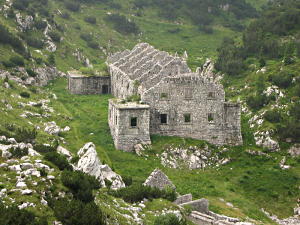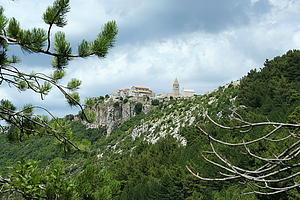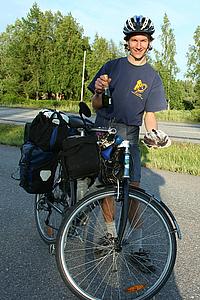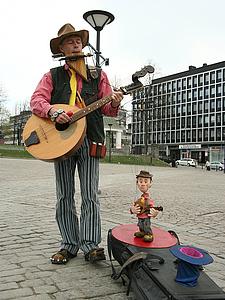Arto's Blog
Pages: << 1 ... 9 10 11 ...12 ...13 14 15 ...16 ...17 18 19 ... 27 >>
Triglav - open air war museum in a national park
Posted: 2008-07-26 16:28:24, Categories: Travel, Slovenia, Hitchhiking, 800 words (permalink)
 Triglav national park in Western Slovenia has beautiful alpine scenery, but it is also a kind of open air museum of the First World War. I did a five day trek in the southern parts of the park.
Triglav national park in Western Slovenia has beautiful alpine scenery, but it is also a kind of open air museum of the First World War. I did a five day trek in the southern parts of the park.
After my sightseeing tour in Venice I spent a couple of relaxed days in Udine, Italy. My CouchSurfing host Katia introduced me to the restaurant and community Casa del Campo, where we spent late evenings in a homely atmosphere. I also bought gas for my gas cooker, stocked up on food supplies and spent quite a few hours in front of Katia's computer reading and writing emails. Then I took a train further east to Cividale, hitchhiked to Kobarid, Slovenia and started walking from there the following day.
Climbing with an overloaded backpack wearing sneakers instead of proper hiking shoes was slow. I only made about 1000 meters uphill during the first afternoon. It started raining but I found a small cottage which was apparently sometimes used by shepherds or forest rangers. The door was locked but there was a perfect place for my sleeping bag on the terrace. For a while just before the sunset clouds gave way to the sun which illuminated beautifully the village below in the valley.
In the morning two men arrived with portable mine detectors. They told that old ammunition and land mines from the First World War still remained in the area. Further up the bloody history of the region became more and more evident. On the mountain ridge near the Krn peak there was a monument, rusty shells set up for display and old barbed wire here and there. Inside the Batognica mountain criss-crossed a network of tunnels which had been used as bunkers and ammunition storage. Italian and Austro-Hungarian armies were fighting against each other and eventually the whole peak of Batognica was blown off, making the mountain some 50 meters lower than it originally was. I only went a couple of dozen meters inside the tunnels but a local told me that some hikers had even got lost in them.
I climbed on the top of Krn which offered a superb view in all directions, particularly towards the Krn lake and northern parts of the park. The peak of Triglav mountain, where the name of the whole park comes from, was mostly hiding behind the clouds so I'm not sure if I saw it or not. After taking some photos I descended to the Krn lake and spent the night in the nearby mountain hut. Following morning I continued north-east towards the valley of Triglav lakes (Dolina Triglavshkih jezer), also known as the valley of seven lakes.
The Komna highlands had more remains from the war times. Walls of old stone buildings stood still strong in the valleys, looking like they can still resist at least a few more centuries. Roofs and windows were gone, grass and flowers were pushing out from everywhere there was even a tiny patch of soil. Hiking paths followed old wartime roads. The paths had clearly been constructed with more effort than a regular hiking trail would have been, but the last vehicle had passed long, long ago and now they already blended nicely with the nature.
Camping was forbidden in Triglav, the only officially allowed places to stay overnight were staffed mountain huts. I personally think camping in national parks should be allowed or there should be at least some designated campsites, to make nature accessible to everyone, with or without money. Of course it would have been easy to find nice hidden spots for wild camping, and the hut personnel didn't seem to be too strongly against it. When they asked if I'd like to stay in the hut, and I replied "Oh, I'd prefer to sleep outdoors :)", they'd smile and answer something like "Ah, we know, but you'll have to hide from the Triglav men." Then they'd put me up with a group of scouts or otherwise their most modest offering, two times out of three with alpinist discounts although I didn't have any club membership card to present. Also otherwise the people were very nice and friendly, so I stayed at the huts and didn't camp.
I had originally intended to continue north-east, near the highest peak (Triglav) and descend on the other side, but due to rainy weather I changed my plans. From the hut of Triglav lakes (Koča Pri Triglavskih Jezerih) I headed south-east, coming down at Stara Fuzina. There I washed off the sweat in the Bohinj lake and hopped in a bus to Ljubljana, the capital of Slovenia. The bus stopped in Bled, which is famous for its scenery. After the real mountains it failed to impress me, one hour walk around was enough of Bled.
How to "do Venice" in two hours
Posted: 2008-07-16 14:51:01, Categories: Travel, Italy, 512 words (permalink)
 I, my mother and two brothers had been walking along the streets of Murano island for a couple of hours, looking at pretty glass objects. We had also recently finished a three course lunch and shopped some fruit and wine in a supermarket to bring back home. It was half past five and about the time to leave. My mother thought it would be still nice to see the San Marco square, probably the most famous spot in Venice. Oh, it was going to be a bit tight but we would still have time to do it.
I, my mother and two brothers had been walking along the streets of Murano island for a couple of hours, looking at pretty glass objects. We had also recently finished a three course lunch and shopped some fruit and wine in a supermarket to bring back home. It was half past five and about the time to leave. My mother thought it would be still nice to see the San Marco square, probably the most famous spot in Venice. Oh, it was going to be a bit tight but we would still have time to do it.
We hopped on the 17:42 waterbus towards the main island of Venice and got off at Fondamente Nove. From there we started walking towards the square, of course faster than most other people were walking. We stopped at a local bakery to buy five pieces of chocolate cake and packed them in my backpack on the way. We also took pictures on the Rialto bridge, which presented the essential Venetian atmosphere in about one minute.
When reaching the San Marco square we heard the chime of the church bells, saw the facade of the famous Basilica and watched pigeons eating breadcrumbs on a girls head. Everything was naturally recorded in photos. While rushing towards the west end of the square we even enjoyed a few tunes of the orchestra playing on the stage.
Our hotel was located quite far in the south-western corner of Venice, so we had to speed up our steps a bit. Nevertheless we saw the Accademia bridge and took a photo of a nice flower arrangement in front of a window by the canalside. When approaching the hotel to pick up our luggage we started already to laugh at the whole last minute sightseeing tour, suggesting each other more targets "to do".
But it was not the time to laugh yet. While others used the hotel bathroom, I downloaded photos from the camera to the laptop (which was going to go back to Finland along with the camera, my mother and brothers on the evening flight) and further to a mobile hard disk so that there would be a picture to add to this blog entry. Then we picked up our bags and suitcases and started running towards Piazzale Roma, where a bus was to leave towards the airport at 19:35.
When we arrived at 19:34, the bus was not there. And it didn't arrive in the next three minutes either. Taxi would have been the easy choice, but a quick search revealed that a local non-direct bus was also heading towards the airport, leaving at 19:40. I helped my mother and brothers to take in the luggage and waved good bye just as the doors closed. As an additional bonus, their waterbus tickets were also valid for the bus.
That was the end of the first part of my summer 2008 Balkans tour. The second part started still the same evening by taking a train to Udine, a town in North-Eastern Italy not far from Slovenian border. But that belongs already to the next story.
The quiet charm of Cres
Posted: 2008-07-13 10:50:40, Categories: Travel, Croatia, 651 words (permalink)
 On the island of Cres in Croatia the traveler can still spot sheep hopping
across the rocks without shepherd, looking as they were lost. In the
traditional way of sheep herding there are no fences, the animals
can come and go freely. Occasionally one of them might get hurt and
die, but vultures make sure that nothing is wasted. Both vultures
and people practising the hundreds of years old trade are currently
under a threat to become extinct. But the island still maintains its charm.
On the island of Cres in Croatia the traveler can still spot sheep hopping
across the rocks without shepherd, looking as they were lost. In the
traditional way of sheep herding there are no fences, the animals
can come and go freely. Occasionally one of them might get hurt and
die, but vultures make sure that nothing is wasted. Both vultures
and people practising the hundreds of years old trade are currently
under a threat to become extinct. But the island still maintains its charm.
Cres has been the highlight of my 12-day trip with my mother and two brothers. We flew to Venice, took a train to Trieste and continued by bus across the border to Slovenia. After two nights in the cute historical town of Piran we rented a car and drove around in Croatia for one week. We started by a short tour around the Istrian peninsula and then took a ferry to Cres.
The first night on the island we stayed in Beli, a small village behind a curvy mountain road. There was an eco center which was maintaining a network of nature trails, cleaning ponds, taking care of injured griffon vultures, hosting an exhibition about wildlife on Cres and generally raising awareness about ecological issues. I wasn't too convinced with the vulture rescue program, which apparently had already resulted in some of the birds becoming too tame. The cages behind the center gave me a feeling of a zoo. Otherwise, the activities of the center seemed to fit the place rather well.
From Beli we drove along more narrow roads to Lubenice, which was like a fairy tale village on top of a hill. By chance we happened to get accommodation in one of the few places offering it, and had an apartment in the first house of the village for one night. Unlike some other villages and towns on the coast, Lubenice didn't show any signs of conversion to a seaside holiday resort. Perhaps being 378 meters above sea level was enough to prevent that. My CouchSurfing friend Slaven told us that there were only 12 permanent inhabitants left. Some more came to stay during the summer, and tourists were strolling along the alleys during the afternoon, but after sunset and in the early morning it was a quiet place.
A hiking path went down to the seashore, ending at a beach by the Blue Cave. The entrance of the cave was in the water about 20 meters swim away from the beach. There were a few chambers, some so deep that swimming was the only way to go, some low enough that I could reach the bottom with my feet. At the end of the last chamber the water was glowing in bright blue. A dive into the light, some meters underwater, then up ... and I was in the open air again. A truly spectacular place.
Another nature sight worth mentioning was the Plitvicka Jezera national park on Croatian mainland. I've never seen so many waterfalls in one day. Even better than the waterfalls were the views to the lakes showing all their best colors in the sunlight. Fish and vegetation could be clearly seen through the crystal clear waters. The visit to Plitvicka was far from a lonely and quiet experience — at least during the peak summer season the park is full of tourist groups. Still, it's special enough to be seen, even if having to queue in the line. Try to wake up early (we didn't) because the waterfalls are in the sunlight only until early afternoon.
I'm posting this in Ljubljana, Slovenia. I'll still go to Venice together with my mother and brothers but there our ways will separate. They have a return flight to Finland but I'll continue to explore the Balkans. Perhaps I'll find some nice sites to pitch my tent which I've been now just carrying from hotel to hotel.
Bicycle 40000 km celebration
Posted: 2008-06-26 13:40:50, Categories: Travel, Finland, Ecology, Cycling, 542 words (permalink)
 On Wednesday 18th of June, on the way to Åland islands together
with my Lithuanian friend Dalia, my bicycle reached 40000 km. Such a
happy moment was certainly a good reason for celebration, so we
offered it flowers, a cake which looked like a cycling helmet, and a
small bottle of sparkling wine. Well, the bicycle actually prefers
chain oil, so we helped it by eating the cake and drinking the wine
ourselves. It was a small bottle, so we weren't too drunk to ride
forwards after the party. :)
On Wednesday 18th of June, on the way to Åland islands together
with my Lithuanian friend Dalia, my bicycle reached 40000 km. Such a
happy moment was certainly a good reason for celebration, so we
offered it flowers, a cake which looked like a cycling helmet, and a
small bottle of sparkling wine. Well, the bicycle actually prefers
chain oil, so we helped it by eating the cake and drinking the wine
ourselves. It was a small bottle, so we weren't too drunk to ride
forwards after the party. :)
I had switched the cyclocomputer to show the total distance already twenty kilometers before the event. When it reached the magic figure, I squeaked the horn, we stopped and had a photo shoot and party on the spot. Very appropriately we happened to be on the King's Road, and there was a bicycle way next to the main road. People in the neighboring house were surely a bit curious what on earth we were doing, but they were too shy to come and ask.
The bike has now been in 22 countries and although it still hasn't traveled around the world, 40000 km is the equivalent distance. I bought the bike in May 2001 and have been riding it since then except for one year while being an exchange student in Japan 2002-2003 (I had another bicycle there). That makes an average of about 6500 km per year. Roughly half of it has been tours and shorter recreational outings, the other half being commuting and other everyday use. Everyday use includes also plenty of icy, snowy, slushy and rainy days during winters.
It's a year 2001 model of Nishiki Hybrid 601, a fairly standard decent quality hybrid bicycle. The frame, handlebar, brakes, gear shifter levers, front shifter, stand and plastic fenders (!) are still originals. Front fork, rims, crankset and pedals have all been changed once, rear shifter and seat twice. It's probably running about the eight chain and sixth rear cassette now, and the third set of chainrings in the front. It has the third set of summer tyres (not counting the originals which were crappy and quickly replaced) and second set of winter tyres. Brake pads and wires of both brakes and shifters have been changed several times. I have a habit of changing the brake wires once per year or at least every second year, even if they still look okay.
The luggage rack in the back is probably much older than the bike itself. I had two aluminum racks which both broke after about 15000 km. After the second breakdown I switched to a sturdy steel rack ripped from an old touring bike in Romania. Despite being slightly rusty, the current rack will probably last much longer than the previous ones. For touring, I've also added rear panniers, a handlebar bag (summer 2005), bar ends, a mirror (changed twice) and two drinking bottles. Last but not least, the bike is equipped with two locks, the cyclocomputer which shows speed and distance, a small funny horn, a seashell from the Black Sea coast and a collection of stickers from different countries.
Many people have asked whether the bike has a name. No, it doesn't, it's simply an old pal. But I just created a small picture gallery for it.
Small hitchhiking adventures
Posted: 2008-05-23 14:53:05, Categories: Travel, Finland, Hospitality exchange, Hitchhiking, 853 words (permalink)
 The first weekend of May I traveled to Hämeenlinna and Riihimäki
— both less than 100 km away from where I live. I met a Russian
marionette artist, a Peruvian musician and a group of Finnish
rock fans. They all picked me up from the roadside.
The first weekend of May I traveled to Hämeenlinna and Riihimäki
— both less than 100 km away from where I live. I met a Russian
marionette artist, a Peruvian musician and a group of Finnish
rock fans. They all picked me up from the roadside.
Still a few years ago it didn't cross my mind to hitchhike. My traveling style was fairly modest, but I always had enough money for the bus or train ticket. So I didn't have to waste time standing by the dusty roadside and rely on luck in getting to my destinations. I hitched a couple of short rides in places where there was no public transport, but that was it.
When I joined the hospitality exchange networks, one of the side effects was that I started meeting hitchhikers. I hosted a few and listened to others in story telling circles during meetings. It was clear that there was more to them in hitchhiking than saving money. It was a way to meet interesting people and to leave room for surprises to happen. I had already decided that I'd try some day, and then one of my guests, a Russian girl called Julia, invited me to hitchhike with her to Hämeenlinna.
I live only 1 km away from where the highway starts, so it was just a short walk to the best spot. In about two minutes an old van with Russian plates stopped and the driver waved us to hop in. His name was Vlad, a musician and marionette artist who had lived for the last 20 years wandering around Europe, performing on the streets and entertaining children in kindergartens. Vlad was just on his way to Hämeenlinna to play on the main square - what a happy coincidence!
So we got a ride to Hämeenlinna in good company, I spent a nice sunny afternoon walking around with Julia, and of course we saw Vlad's performance too. There weren't too many spectators as it was the official hangover day after Vappu (as Vlad put it), but at least he got two more by picking us up. Then we each went our own ways, me taking a bus back to Helsinki because I wanted to be here in time to welcome Tuula, a good friend of mine who was coming for a visit.
Tuula got an idea the next day that we should go and have barbeque and sauna with Jukka, a common friend of ours. Well, Jukka lives in Riihimäki about 70 km from Helsinki so we filled our backpacks with food and walked to the same spot at the beginning of the highway. Again in less than 10 minutes a van stopped. Our driver was a Peruvian musician from the Amerinca group which I had seen several times in Helsinki. I even bought their cd a few years ago. He lived just a few kilometers away from where I and Tuula were going so we got a ride almost to Jukka's doorstep, much closer than a train or bus would have taken us, and got a small insight into the life of a Peruvian-Finnish family on the way.
We spent a relaxed barbeque and sauna evening and slept at Jukka's place. It's funny how hospitality exchange changes habits: we laughed with Tuula on the way that when she called him she didn't even ask if we were welcome to stay overnight. Of course we were. :) In fact Jukka seemed to be more than happy to have us there to cook and chat with.
Next day Tuula hitched back north towards her home and I back to Helsinki. Standing by the highway is forbidden so we chose a spot near one of the exits. Fastest way to get a ride would probably have been to go to the nearby gas station and start asking who would be going to the directions we wanted. However, Tuula said she feels more comfortable not to ask but rather wait for drivers who stop and pick hitchhikers up from free will, and I fully agreed.
This time we had to wait for about half an hour, but then got rides right after each other. Tuula traveled with someone returning from an enduro race, and I got picked up by four Finnish rock fans who were cruising back from a party in Tampere previous night. They had black clothes, big tattoos, funky hairstyles and a 1960's black Chevrolet with a Kajaani Hot Rod Club sticker attached to the rear window. It was a loud ride, I can still remember the sound of the engine at 100 km/h, windows open. With my light blue jacket and hiking backpack I didn't exactly blend in the group — but hey, these people were cool with it.
I recently read an essay by Kevin Kelly titled The Universe Is Conspiring to Help Us, which I liked a lot. It's about the art of receiving, of which hitchhiking is one example. I suggest you to scroll down the page and read also the full version of the essay (direct link), which I find better than the abridged one.
<< 1 ... 9 10 11 ...12 ...13 14 15 ...16 ...17 18 19 ... 27 >>

Copyright Arto Teräs <ajt@iki.fi>, licensed under the Creative Commons Attribution-Share Alike 3.0 Unported License. (Unless otherwise mentioned in individual photos or other content.)